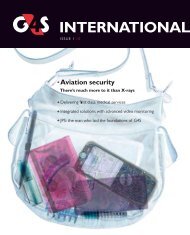G4S Annual Report and Accounts 2011
G4S Annual Report and Accounts 2011
G4S Annual Report and Accounts 2011
You also want an ePaper? Increase the reach of your titles
YUMPU automatically turns print PDFs into web optimized ePapers that Google loves.
Governance Financial statements Shareholder information<br />
3 Significant accounting policies continued<br />
(b) Basis of consolidation continued<br />
Transactions eliminated on consolidation<br />
All intra-group transactions, balances, income <strong>and</strong> expenses are eliminated on consolidation. Where a group company transacts with a joint venture or<br />
associate of the group, profits <strong>and</strong> losses are eliminated to the extent of the group’s interest in the relevant joint venture or associate.<br />
(c) Foreign currencies<br />
The financial statements of each of the group’s businesses are prepared in the functional currency applicable to that business. Transactions in currencies<br />
other than the functional currency are translated at the rates of exchange prevailing on the dates of the transactions. At each balance sheet date, monetary<br />
assets <strong>and</strong> liabilities which are denominated in other currencies are retranslated at the rates prevailing on that date. Non-monetary assets <strong>and</strong> liabilities<br />
carried at fair value which are denominated in other currencies are translated at the rates prevailing at the date when the fair value was determined.<br />
Non-monetary items measured at historical cost denominated in other currencies are not retranslated. Gains <strong>and</strong> losses arising on retranslation are<br />
included in the income statement for the period.<br />
On consolidation, the assets <strong>and</strong> liabilities of the group’s overseas operations, including goodwill <strong>and</strong> fair value adjustments arising on their acquisition, are<br />
translated into sterling at exchange rates prevailing on the balance sheet date. Income <strong>and</strong> expenses are translated into sterling at the average exchange<br />
rates for the period (unless this is not a reasonable approximation of the cumulative effect of the rate prevailing on the transaction dates, in which case<br />
income <strong>and</strong> expenses are translated at the dates of the transactions). Exchange differences arising are recognised in other comprehensive income, together<br />
with exchange differences arising on monetary items that are in substance a part of the group’s net investment in foreign operations <strong>and</strong> on borrowings <strong>and</strong><br />
other currency instruments designated as hedges of such investments where <strong>and</strong> to the extent that the hedges are deemed to be effective. On disposal<br />
translation differences are recognised in the income statement in the period in which the operation is disposed of.<br />
(d) Derivative financial instruments <strong>and</strong> hedge accounting<br />
In accordance with its treasury policy, the group only holds or issues derivative financial instruments to manage the group’s exposure to financial risk, not for<br />
trading purposes. Such financial risk includes the interest risk on the group’s variable-rate borrowings, the fair value risk on the group’s fixed-rate<br />
borrowings, commodity risk in relation to its diesel consumption <strong>and</strong> foreign exchange risk on transactions, on the translation of the group’s results <strong>and</strong> on<br />
the translation of the group’s net assets measured in foreign currencies. The group manages these risks through a range of derivative financial instruments,<br />
including interest rate swaps, fixed rate agreements, commodity swaps, commodity options, forward foreign exchange contracts <strong>and</strong> currency swaps.<br />
Derivative financial instruments are recognised in the consolidated statement of financial position as financial assets or liabilities at fair value. Fair value is<br />
measured using one of the valuation techniques based on one of the three following valuation hierarchies as set out in IFRS7 (Amended):<br />
Level 1 – quoted prices (unadjusted) in active markets for identical assets or liabilities;<br />
Level 2 – inputs other than quoted prices included within Level 1 that are observable for the asset or liability, either directly (i.e. as prices) or indirectly<br />
(i.e. derived from prices); <strong>and</strong><br />
Level 3 – inputs for the asset or liability that are not based on observable market data (unobservable inputs)<br />
The gain or loss on re-measurement to fair value is recognised immediately in the income statement, unless the derivatives qualify for hedge accounting.<br />
Where derivatives do qualify for hedge accounting, the treatment of any resultant gain or loss depends on the nature of the item being hedged as described<br />
below.<br />
Fair value hedge<br />
The change in the fair value of both the hedging instrument <strong>and</strong> the related portion of the hedged item is recognised immediately in the income statement.<br />
Cash flow hedge<br />
The change in the fair value of the portion of the hedging instrument that is determined to be an effective hedge is recognised in equity <strong>and</strong> subsequently<br />
recycled to the income statement when the hedged cash flow impacts the income statement. The ineffective portion of the fair value of the hedging<br />
instrument is recognised immediately in the income statement.<br />
Net investment hedge<br />
The change in the fair value of the portion of the hedging instrument that is determined to be an effective hedge is recognised in equity <strong>and</strong> subsequently<br />
recycled to the income statement when the hedged net investment impacts the income statement. The ineffective portion of the fair value of the hedging<br />
instrument is recognised immediately in the income statement.<br />
(e) Intangible assets<br />
Goodwill<br />
All business combinations are accounted for by the application of the acquisition method. Goodwill arising on consolidation represents the excess of the<br />
cost of acquisition over the group’s interest in the fair value of the identifiable assets <strong>and</strong> liabilities <strong>and</strong> contingent liabilities of a subsidiary, associate or<br />
jointly-controlled entity at the date of acquisition. No goodwill arises on the acquisition of an additional interest from a non-controlling interest in a<br />
subsidiary as this is accounted for as an equity transaction. Goodwill is stated at cost, less any accumulated impairment losses, <strong>and</strong> is tested annually for<br />
impairment or more frequently if there are indications that amounts may be impaired. In respect of associates, the carrying amount of goodwill is included<br />
within the net investment in associates. On disposal of a subsidiary, associate or jointly controlled entity, the attributable amount of goodwill is included in<br />
the determination of the profit or loss on disposal.<br />
Goodwill arising on acquisitions before transition to IFRS on 1 January 2004 has been retained at the previous UK GAAP amounts, subject to being tested<br />
for impairment at that date. Goodwill written off to reserves under UK GAAP prior to 1998 has not been reinstated <strong>and</strong> is not included in determining any<br />
subsequent profit or loss on disposal.<br />
<strong>G4S</strong> plc<br />
<strong>Annual</strong> <strong>Report</strong> <strong>and</strong> <strong>Accounts</strong> <strong>2011</strong><br />
79











